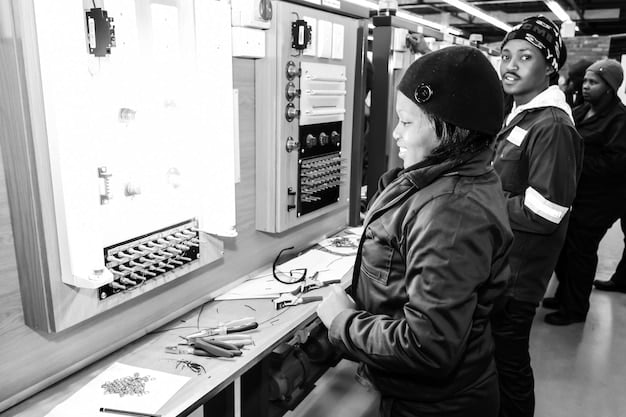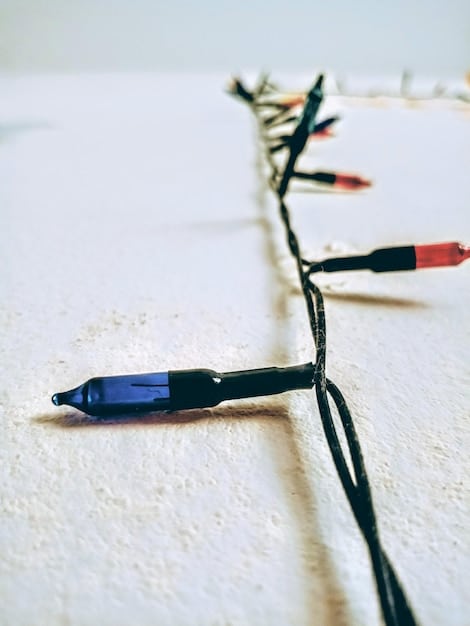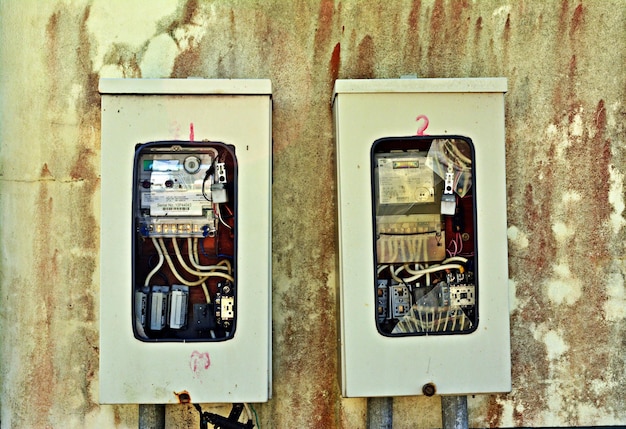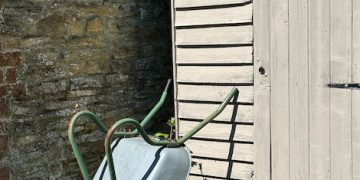Upgrade Your Home’s Wiring: Safety and Modernisation

Anúncios
Upgrading your home’s wiring is essential for ensuring safety by preventing electrical hazards, accommodating modern energy demands, and increasing your property’s value through enhanced electrical capacity and reliability.
Is your home’s electrical system struggling to keep up with your modern lifestyle? It might be time to consider an upgrade your home’s wiring: ensure safety and modernise your electrical system. Outdated wiring can be a safety hazard and limit your ability to use modern appliances and technologies. Read on to discover how to ensure your home is safe and functional.
Anúncios
Why Upgrade Your Home’s Wiring?
Upgrading your home’s wiring might seem like a daunting task, but its benefits extend far beyond simply adding more outlets. Modernising your electrical system enhances safety, supports increased power demands, and boosts your home’s overall value.
Let’s explore why this home improvement project is crucial for every homeowner.
Anúncios
Enhanced Safety
Older wiring systems are often unable to handle the demands of modern appliances and electronics. This can lead to overloaded circuits, which are a primary cause of electrical fires. By upgrading your wiring, you reduce the risk of electrical fires and shocks, ensuring a safer living environment for you and your family.
Modern wiring also includes essential safety features like ground fault circuit interrupters (GFCIs) and arc fault circuit interrupters (AFCIs), which provide additional protection against electrical hazards.
Supporting Increased Power Demands
As technology advances, the energy consumption of our homes increases. From high-definition TVs and gaming consoles to electric vehicle chargers and smart home devices, modern appliances require a stable and robust electrical system. Upgrading your wiring allows your home to handle these increased power demands without experiencing frequent power outages or system failures.
By upgrading, you’ll ensure the seamless operation of all your electrical devices, providing convenience and reliability.

Boosting Home Value
Homes with updated electrical systems are more attractive to potential buyers. A modernised wiring system indicates that the home is well-maintained and equipped to handle the electrical demands of contemporary living. This can significantly increase your property’s market value and make it more competitive on the real estate market.
Furthermore, upgrading your wiring can be a selling point that attracts environmentally conscious buyers interested in energy-efficient homes.
Investing in an upgrade your home’s wiring not only enhances its safety and functionality but also provides a significant return on investment by boosting its overall value.
Recognise the Signs You Need an Upgrade
Identifying the signs that indicate your home’s wiring needs an upgrade is critical for preventing potential hazards. Understanding these warning signs allows you to take timely action and ensure a safer, more efficient electrical system.
Here’s what to look out for:
Flickering Lights
One of the most common and noticeable signs of outdated or inadequate wiring is frequent flickering of lights. This can occur when the electrical system is struggling to provide consistent power to the lighting fixtures.
If you notice your lights flickering, dimming, or brightening unexpectedly, it’s a clear indication that your wiring may need professional attention.
Burning Smells
Any unusual burning smell coming from outlets, switches, or appliances should be taken seriously. This smell often indicates that wires are overheating due to overloaded circuits or faulty connections.
Ignoring burning smells can lead to electrical fires, so it’s essential to immediately investigate and address the source of the odour.
Warm Outlets or Switches
Outlets and switches should not feel warm to the touch under normal use. If you notice that your outlets or switches are warm, it suggests that there may be an issue with the wiring behind them.
This could be due to loose connections or overloaded circuits, which can pose a safety risk. Contact a qualified electrician to inspect and repair the affected areas.

Tripping Breakers
Frequent tripping of circuit breakers is another sign that your electrical system is struggling to handle the electrical load. Circuit breakers are designed to protect your home from electrical fires by shutting off power when a circuit is overloaded.
If your breakers are tripping regularly, it may be necessary to upgrade your wiring to accommodate the increased power demands of your modern appliances.
Visible Wear and Tear
Visible signs of wear and tear on your wiring, such as frayed wires, cracked insulation, or corroded connections, indicate that your electrical system is deteriorating. These issues can compromise the safety and efficiency of your wiring and increase the risk of electrical hazards.
If you notice any visible signs of wear and tear, it’s crucial to have your wiring inspected and repaired by a qualified electrician.
Being aware of these signs allows you to identify potential electrical issues early and take proactive steps to ensure the safety and reliability of your home’s electrical system.
Planning Your Wiring Upgrade
Proper planning is essential for a successful wiring upgrade. Taking the time to assess your electrical needs, create a detailed plan, and obtain necessary permits ensures a smooth and efficient upgrade process.
Here’s what you need to consider:
Assess Your Electrical Needs
Begin by evaluating your current and future electrical needs. Consider the number of appliances and electronics you use regularly, as well as any planned additions or renovations that may increase your power consumption. Identify any circuits that are frequently overloaded or any areas where you need additional outlets or lighting.
This assessment will help you determine the scope of your wiring upgrade and ensure you have adequate electrical capacity for your lifestyle.
Create a Detailed Plan
Develop a detailed plan outlining the specific areas of your home that require wiring upgrades, the type of wiring to be used, and the placement of new outlets, switches, and fixtures. Include a comprehensive layout of your electrical system, noting the location of circuit breakers, wiring routes, and grounding points.
A well-defined plan will serve as a roadmap for your electrician and ensure that the upgrade is completed efficiently and accurately.
Obtain Necessary Permits and Inspections
Before starting any electrical work, check with your local authorities to determine if any permits are required. Electrical work often requires permits to ensure compliance with local building codes and safety regulations. Obtain the necessary permits and schedule inspections at various stages of the upgrade process.
Inspections help verify that the work is being done correctly and that your electrical system meets the required safety standards.
- Hire a Licensed Electrician:
- Use Quality Materials:
- Consider Energy Efficiency:
Careful planning ensures that your wiring upgrade meets your electrical needs, complies with local regulations, and provides a safe and reliable electrical system for your home.
Hiring a Qualified Electrician
Choosing the right electrician is crucial for a successful wiring upgrade. A qualified electrician brings expertise, experience, and professionalism to the job, ensuring that the work is done safely and to code.
Here’s how to choose the right electrician:
Check Credentials and Licensing
Verify that the electrician is licensed to perform electrical work in your area. Licensing ensures that the electrician has met the necessary training and competency requirements. Ask for proof of insurance to protect yourself from liability in case of accidents or damage during the upgrade.
Checking credentials and licensing ensures that you are hiring a qualified and reputable professional.
Read Reviews and Get Referrals
Research the electrician’s reputation by reading online reviews and testimonials from previous customers. Ask for referrals from friends, family, or neighbours who have had similar electrical work done. Good reviews and positive referrals are indicators of a reliable and trustworthy electrician.
Reading reviews and getting referrals provides valuable insights into the electrician’s quality of work and customer service.
Get Multiple Quotes
Obtain quotes from several electricians before making a decision. Compare the quotes to ensure that you are getting a fair price for the work to be done. Be wary of quotes that are significantly lower than others, as this may indicate substandard work or materials.
Getting multiple quotes allows you to compare prices, services, and warranties, helping you make an informed decision.
By carefully evaluating electricians and choosing a qualified professional, you can ensure that your wiring upgrade is completed safely, efficiently, and to the highest standards.
Understanding Wiring Types
Understanding the types of wiring used in your home is essential for ensuring a safe and efficient electrical system. Different types of wiring are designed for specific applications and have unique properties that make them suitable for various electrical needs.
Let’s explore the common types of wiring found in homes:
Non-Metallic (NM) Cable
Non-Metallic (NM) cable, often referred to as Romex, is one of the most common types of wiring used in residential buildings. It consists of two or more insulated conductors wrapped in a plastic jacket. NM cable is used for interior wiring in dry locations, such as branch circuits for outlets, switches, and lighting fixtures.
It is available in various sizes, such as 14-gauge, 12-gauge, and 10-gauge, each designed for different amperage ratings.
Underground Feeder (UF) Cable
Underground Feeder (UF) cable is designed for direct burial in the ground and is used for outdoor wiring applications. It is similar to NM cable but has a more robust, moisture-resistant jacket that protects it from the elements. UF cable is commonly used for powering outdoor lighting, pumps, and other devices located outside the home.
It is suitable for wet locations and can withstand exposure to harsh environmental conditions.
Metallic Conduit
Metallic conduit is used to protect electrical wiring from physical damage and moisture. It consists of metal tubing through which insulated wires are run. Conduit provides a durable and grounded enclosure for wiring, reducing the risk of electrical shorts and fires. It is commonly used in exposed locations or where wiring needs to be protected from mechanical stress.
- Armoured Cable (AC):
- Electrical Metallic Tubing (EMT):
By understanding the types of wiring used in your home, you can make informed decisions about electrical upgrades and ensure that your wiring system is safe and efficient.
Safety Precautions During the Upgrade
Taking safety precautions during a wiring upgrade is paramount to prevent accidents and ensure a safe working environment. Electrical work can be hazardous, so it’s essential to follow safety guidelines and use appropriate protective equipment.
Here are crucial safety precautions to observe:
Turn Off the Power
Before starting any electrical work, always turn off the power to the circuit you will be working on. Locate the appropriate circuit breaker in your electrical panel and switch it to the “off” position. Use a voltage tester to verify that the circuit is indeed de-energized before touching any wires.
Turning off the power is the most critical safety precaution to prevent electrical shocks.
Wear Protective Gear
Wear appropriate protective gear, such as insulated gloves and eye protection, to minimize the risk of electrical shocks and injuries. Insulated gloves provide a barrier against electrical current, while eye protection shields your eyes from sparks or debris.
Wearing protective gear helps safeguard you from potential hazards during electrical work.
Use Insulated Tools
Use tools with insulated handles specifically designed for electrical work. Insulated tools provide an additional layer of protection against electrical shocks if you accidentally come into contact with a live wire. Inspect your tools regularly for any signs of damage or wear and replace them as needed.
Using insulated tools reduces the risk of electrical shocks and enhances safety during electrical tasks.
Work in Dry Conditions
Avoid working with electrical wiring in wet or damp conditions. Water is an excellent conductor of electricity, so working in wet environments significantly increases the risk of electrical shocks. Ensure that the area is dry and well-ventilated before commencing electrical work.
Working in dry conditions minimizes the risk of electrical shocks and promotes a safer working environment.
By adhering to these safety precautions, you can create a safe working environment and minimize the risk of accidents during your wiring upgrade.
| Key Point | Brief Description |
|---|---|
| 💡Importance of Upgrade | Safety, power demands, and increased home value. |
| ⚠️Signs You Need It | Flickering lights, burning smells, warm outlets. |
| 🛠️Planning & Execution | Assess needs, create a plan, get permits, hire experts. |
| 🛡️ Safety First | Turn off power, wear protective gear, use insulated tools. |
Frequently Asked Questions
▼
You should consider upgrading your home’s wiring if it’s over 25 years old or if you’re experiencing frequent electrical issues. Also, upgrades are essential when adding major appliances or renovating your home.
▼
While some minor electrical repairs can be DIY, upgrading your home’s wiring is best left to a licensed electrician. They have the expertise to ensure the job is done safely and correctly, adhering to local codes.
▼
The duration of a wiring upgrade varies depending on the size and complexity of the project. A typical upgrade can take anywhere from a few days to a week. Your electrician will provide a timeline during the planning phase.
▼
Common signs include flickering lights, frequent tripping of circuit breakers, burning smells from outlets, and warm outlets or switches. If you notice any of these, consult with an electrician.
▼
The cost of upgrading your home’s wiring varies based on the size of your home, the extent of the upgrade, and local labour rates. It’s best to get quotes from multiple electricians to compare prices and services.
Conclusion
Upgrading your home’s wiring is a significant investment in safety, functionality, and value. By recognising the signs of outdated wiring, planning the upgrade carefully, and hiring a qualified electrician, you can ensure a modern and reliable electrical system that meets the demands of today’s technology.





